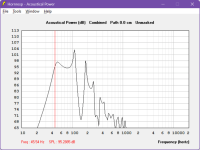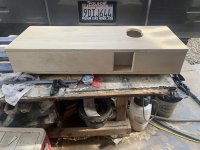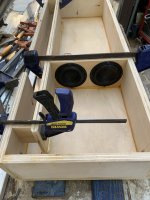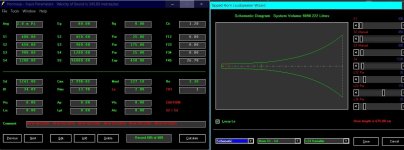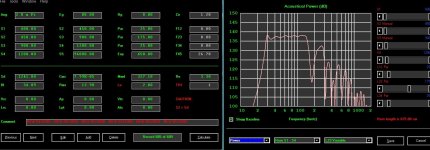And then you proceed to share your 60hz ‘sub’ woofer, 🤡
Also, it is a BP4 enclosure and not a BR or BP6. Below tuning, a BP4 performs as a sealed enclosure.
Measure a sealed enclosure with a F3 of 55hz outside on the ground and then measure the same enclosure in a vehicle. Betcha the F3 is WAY below 55hz that HR cannot predict at 0.5pi.
And remember, the enclosure was designed for an extended cab COMPACT pickup. The cabin is SMALL which BOOSTS cabin GAIN.
Tuning a BP4 below 50hz gives you that "1 note" bass in a car. It's cool for SPL, but not SQ.
I've been trying to find an article where a guy built a FLH for a Subaru wagon. I think his tune was around 70-80hz. He kept raising the tune to get rid excess low bass (or add midbass).
Lets @$$-U-me that the teal line below was from my 1996 Ford Ranger SuperCab's transfer function (TF).
TF @ 80hz = 0dB.
TF @ 40hz = +14dB.
2pi BP4 @ 80hz = 131dB.
2pi BP4 @ 40hz = 118dB.
BP4 131dB + TF 0dB = 131dB @ 80hz.
BP4 118dB + TF 14dB = 132dB @ 40hz.
So with a 74hz tuned BP4, I went from a ground plane F3 of 55hz to an in car F3 in the mid to low 30hz range.
TF @ 30hz = +16dB.
2pi BP4 @ 30hz = 111dB.
111dB + 16 = 127db @ 30hz.
131dB - 127dB = F4 @ 30hz.
GET OFF my 2009 BP4 😆🤣
https://www.diyaudio.com/community/threads/transfer-function-measurement-and-use.350963/
I'd be curios to know the enclosure tune of the red line below.
A scoop bin is a back loaded horn.
Some like the Martin bass bins are horns that don’t go very low with the back if the driver loading into a sealed box.
dave
Open a window (and then the doors) and the cabin goes from a Helmholtz resonator to a stubby 1/4 wave resonator maybe?Also, it is a BP4 enclosure and not a BR or BP6. Below tuning, a BP4 performs as a sealed enclosure.
Measure a sealed enclosure with a F3 of 55hz outside on the ground and then measure the same enclosure in a vehicle. Betcha the F3 is WAY below 55hz that HR cannot predict at 0.5pi.
And remember, the enclosure was designed for an extended cab COMPACT pickup. The cabin is SMALL which BOOSTS cabin GAIN.
Tuning a BP4 below 50hz gives you that "1 note" bass in a car. It's cool for SPL, but not SQ.
I've been trying to find an article where a guy built a FLH for a Subaru wagon. I think his tune was around 70-80hz. He kept raising the tune to get rid excess low bass (or add midbass).
Lets @$$-U-me that the teal line below was from my 1996 Ford Ranger SuperCab's transfer function (TF).
TF @ 80hz = 0dB.
TF @ 40hz = +14dB.
2pi BP4 @ 80hz = 131dB.
2pi BP4 @ 40hz = 118dB.
BP4 131dB + TF 0dB = 131dB @ 80hz.
BP4 118dB + TF 14dB = 132dB @ 40hz.
So with a 74hz tuned BP4, I went from a ground plane F3 of 55hz to an in car F3 in the mid to low 30hz range.
TF @ 30hz = +16dB.
2pi BP4 @ 30hz = 111dB.
111dB + 16 = 127db @ 30hz.
131dB - 127dB = F4 @ 30hz.
GET OFF my 2009 BP4 😆🤣
https://www.diyaudio.com/community/threads/transfer-function-measurement-and-use.350963/
I'd be curios to know the enclosure tune of the red line below.
View attachment 1358532View attachment 1358533
A scoop bin is a back loaded horn.
Its a BR with positive flare port.
I did say when the driver is mounted offset in the horn's path, that the enclosure could be modeled as compression chambered TH.
Left = compression chambered TH.
Right = offset driver BR with positive flare port.
Using BW's TL speaker data.
BANDPASS RULES!
Open a window (and then the doors) and the cabin goes from a Helmholtz resonator to a stubby 1/4 wave resonator maybe?
Something like that, and you get MORE SPL.
That's why SPL competitions have sealed kick panel, sealed windshield, 1 window down, and 1 door open measurements.
It's a box inside a box type of deal.
Your car is a BP4 enclosure with a sealed box in the trunk and a window down.
Your car is a BP6S enclosure with a BR box in the trunk and a window down.
Your car is a BP8P enclosure with a BP6P box in the trunk and a window down.
BANDPASS RULES!!!
Aren't all FLH's (positive flare port), TH's, and TL's QW's?Clearly, and unquestionably a 1/4 wave resonator, and one with the port exit and driver in such close proximity that you even get the full wavelength cancelation notches(a lot like lazy shaped ‘tapped horn’ as you mentioned
They are tuned by the foot and not by the inch like BR's and BP4's (straight flare ports).
Everything has 1/4 wave resonances if you look/listen without a crossover maybe? Except a really small bass reflex /helmholtz shaped resonatur/function ?
Well, we did prove that you built an 8th order enclosure based on your measurements and physical design.
Everything has 1/4 wave resonances if you look/listen without a crossover maybe?
What's the point when we NORMALLY listen to SUBwoofers WITH low pass filters.
The think the point is ‘how does it actually work and how can we learn to appreciate/understand that instead of just ignore it and ‘know’ nothing ?
I can’t seem to figure out how to make a decent ‘8th order‘ . except for two parallel qw resonators (separated in length, by their odd harmonic interval) and then complimented by a very large series exit qw resonator …. But it requires the very nice PA drivers and a ridiculous sized box that is so far beyond reasonable that it’s just mental masturbation in horn responseWell, we did prove that you built an 8th order enclosure based on your measurements and physical design.
Everything has 1/4 wave resonances if you look/listen without a crossover maybe? Except a really small bass reflex /helmholtz shaped resonatur/function ?
Anything gives you huge problems and disadvantages if you use it wrong. Why would you hammer a screw in? Same goes for a subwoofer, why would you use it without a LP filter?!
I can’t seem to figure out how to make a decent ‘8th order‘ . except for two parallel qw resonators (separated in length, by their odd harmonic interval) and then complimented by a very large series exit qw resonator …. But it requires the very nice PA drivers and a ridiculous sized box that is so far beyond reasonable that it’s just mental masturbation in horn response
There is an 8th order thread on this forum (also check the HR thread when DMB added the function to HR). I think they model a small BP8 with good performance.
THANK YOU!!!Anything gives you huge problems and disadvantages if you use it wrong. Why would you hammer a screw in? Same goes for a subwoofer, why would you use it without a LP filter?!
Or a ’tapped qw resonator‘ fed into a real horn like this which is totally impossible to actually build but the holy grail of ultimate …..
https://www.livedesignonline.com/sp...ld-and-wacky-loudspeaker-systems-around-world
Or a ’tapped qw resonator‘ fed into a real horn like this which is totally impossible to actually build but the holy grail of ultimate …..
Well, it looks surely nice from the predicted response but that ignores the group delay and decay. And I can promise you, that will be horrible.
- Home
- Loudspeakers
- Subwoofers
- An idea: A T-line with both ends open
